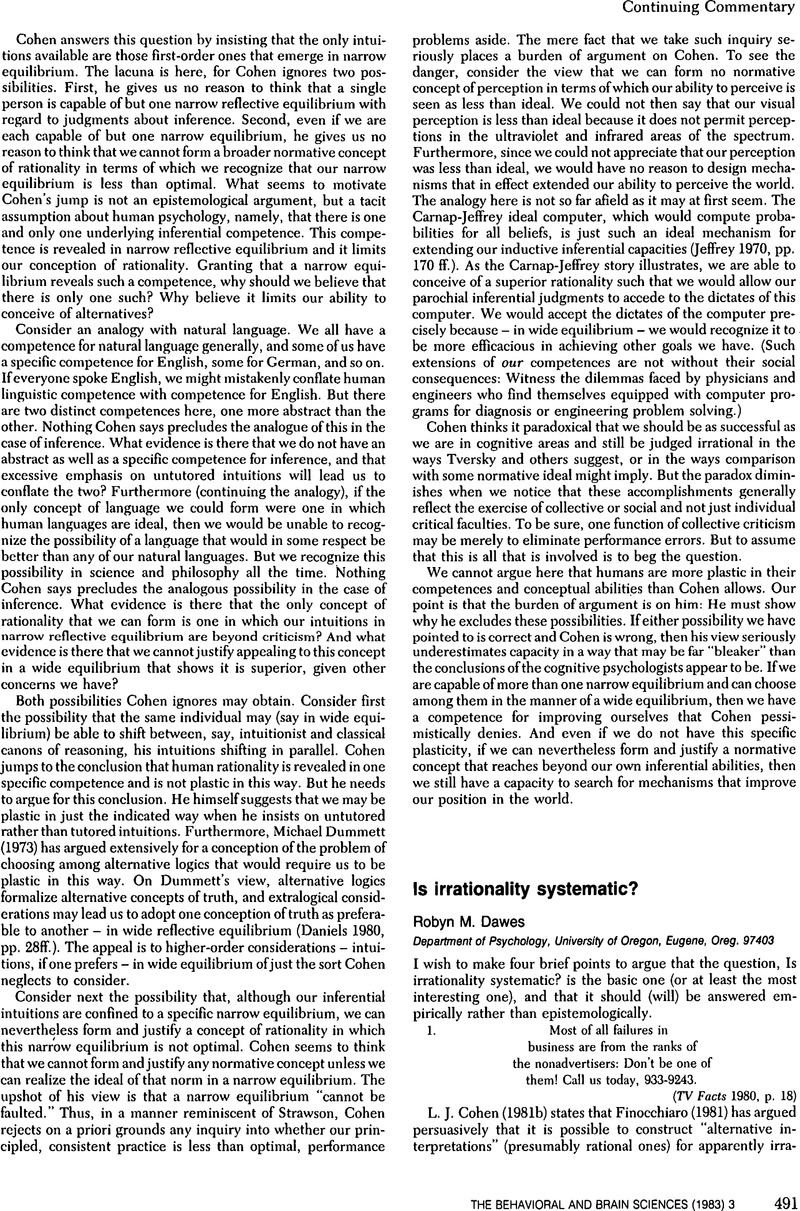Crossref Citations
This article has been cited by the following publications. This list is generated based on data provided by Crossref.
Ayton, Peter
1992.
Expertise and Decision Support.
p.
77.
Vicente, Kim J.
1996.
The perils of reconstructive remembering and the value of representative design.
Behavioral and Brain Sciences,
Vol. 19,
Issue. 1,
p.
40.
Margolis, Howard
1996.
Nuancing should not imply neglecting.
Behavioral and Brain Sciences,
Vol. 19,
Issue. 1,
p.
32.
Quinsey, Vernon L.
1996.
Improving decision accuracy where base rates matter: The prediction of violent recidivism.
Behavioral and Brain Sciences,
Vol. 19,
Issue. 1,
p.
37.
Hamm, Robert M.
1996.
Physicians neglect base rates, and it matters.
Behavioral and Brain Sciences,
Vol. 19,
Issue. 1,
p.
25.
Koonce, Lisa
1996.
Base rates in the applied domain of accounting.
Behavioral and Brain Sciences,
Vol. 19,
Issue. 1,
p.
29.
Callen, Craig R.
1996.
The implications of Koehler's approach for fact finding.
Behavioral and Brain Sciences,
Vol. 19,
Issue. 1,
p.
18.
Gigerenzer, Gerd
1996.
Why do frequency formats improve Bayesian reasoning? Cognitive algorithms work on information, which needs representation.
Behavioral and Brain Sciences,
Vol. 19,
Issue. 1,
p.
23.
Ginzburg, Lev R.
Janson, Charles
and
Ferson, Scott
1996.
Judgment under uncertainty: Evolution may not favor a probabilistic calculus.
Behavioral and Brain Sciences,
Vol. 19,
Issue. 1,
p.
24.
Melone, Nancy Paule
and
McGuire, Timothy W.
1996.
Conservatism revisited: Base rates, prior probabilities, and averaging strategies.
Behavioral and Brain Sciences,
Vol. 19,
Issue. 1,
p.
36.
Dawes, Robyn M.
1996.
The purpose of experiments: Ecological validity versus comparing hypotheses.
Behavioral and Brain Sciences,
Vol. 19,
Issue. 1,
p.
20.
Spellman, Barbara A.
1996.
The implicit use of base rates in experiential and ecologically valid tasks.
Behavioral and Brain Sciences,
Vol. 19,
Issue. 1,
p.
38.
Keren, Gideon
and
Thijs, Lambert J.
1996.
The base rate controversy: Is the glass half-full or half-empty?.
Behavioral and Brain Sciences,
Vol. 19,
Issue. 1,
p.
26.
Connolly, Terry
1996.
Are base rates a natural category of information?.
Behavioral and Brain Sciences,
Vol. 19,
Issue. 1,
p.
19.
Edgell, Stephen E.
Roe, Robert M.
and
Dodd, Clayton H.
1996.
Base rates, experience, and the big picture.
Behavioral and Brain Sciences,
Vol. 19,
Issue. 1,
p.
21.
Funder, David C.
1996.
Base rates, stereotypes, and judgmental accuracy.
Behavioral and Brain Sciences,
Vol. 19,
Issue. 1,
p.
22.
Koehler, Jonathan J.
1996.
The base rate fallacy reconsidered: Descriptive, normative, and methodological challenges.
Behavioral and Brain Sciences,
Vol. 19,
Issue. 1,
p.
1.
Anderson, Norman H.
1996.
Cognitive algebra versus representativeness heuristic.
Behavioral and Brain Sciences,
Vol. 19,
Issue. 1,
p.
17.
Krueger, Joachim
1996.
Studying the use of base rates: Normal science or shifting paradigm?.
Behavioral and Brain Sciences,
Vol. 19,
Issue. 1,
p.
30.
McCauley, Clark
1996.
First things first: What is a base rate?.
Behavioral and Brain Sciences,
Vol. 19,
Issue. 1,
p.
33.


